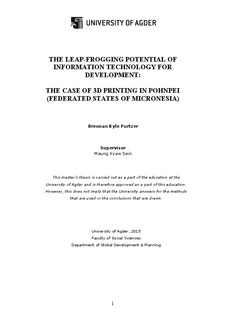| dc.description.abstract | This modified, participatory action research study investigates the potential for 3D
printing for development (3DP4D) on the remote Pacific island of Pohnpei (The
Federated States of Micronesia), specifically in an attempt to visualize opportunities
for the technology to affect the state and national trade imbalance. The study
examines import statistics and coordinates with government leaders and business
managers as stakeholders to eventually generate and recommend a business model to
restructure supply chains to the advantage of islanders. Through the study, the
research classifies Pohnpei as a “Goldilocks Island State”, where demand exists, but
in quantities too small to effectively service through traditional resource strategies.
The research suggests the recommended 3D printing business model may have
applications in other locations where long-distance replacement part sourcing can
cause significant economic strains/drains for micro-economies.
The study reviews available 3D printing technologies, identifies the role of density in
import substitution, and makes suggestions for the technology’s promise in Pohnpei
for such industries as industrial components, automotive/marine and dental
replacements.
The study asserts that certain revolutionary new factors such as bioplastics and
recycled materials are sustainable game-changers for remote locations, and recognizes
great potential to positively affect the trade imbalance that lies in domestic
agricultural policy.
Finally, with 3D printing comes the opportunity to bring limited manufacturing
capabilities, which along with utilizing locally available resources, can permit a type
of insurance buffer as a hedge against international traders, especially for outerislands
where it has historically been impossible for government to provide a full
range of services. | nb_NO |
